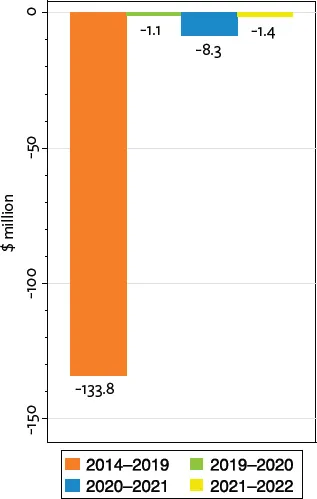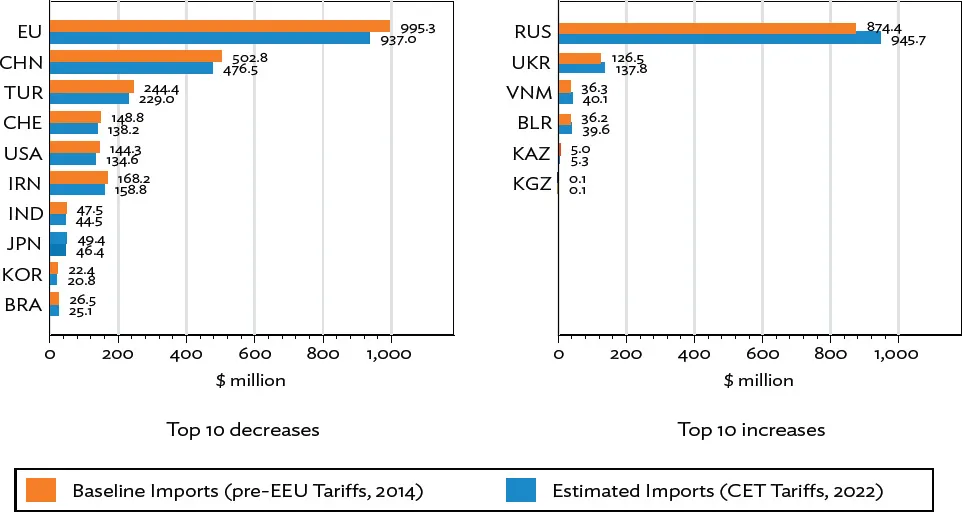
eBook - ePub
The Impact of Tariff Changes on Armenia's Foreign Trade
This is a test
Partager le livre
- 62 pages
- English
- ePUB (adapté aux mobiles)
- Disponible sur iOS et Android
eBook - ePub
The Impact of Tariff Changes on Armenia's Foreign Trade
Détails du livre
Aperçu du livre
Table des matières
Citations
À propos de ce livre
This publication examines the trade and welfare impact of Armenia's convergence to the Common External Tariff of the Eurasian Economic Union (EEU), and how different sectors and products are affected through shifting import and export patterns. It also models trade opportunities created by the recent and potential free trade agreements between the EEU and third countries, using both general and partial equilibrium approaches. Finally, the publication surveys how losing eligibility for the European Union's Generalised Scheme of Preferences will affect Armenia's trade.
Foire aux questions
Comment puis-je résilier mon abonnement ?
Il vous suffit de vous rendre dans la section compte dans paramètres et de cliquer sur « Résilier l’abonnement ». C’est aussi simple que cela ! Une fois que vous aurez résilié votre abonnement, il restera actif pour le reste de la période pour laquelle vous avez payé. Découvrez-en plus ici.
Puis-je / comment puis-je télécharger des livres ?
Pour le moment, tous nos livres en format ePub adaptés aux mobiles peuvent être téléchargés via l’application. La plupart de nos PDF sont également disponibles en téléchargement et les autres seront téléchargeables très prochainement. Découvrez-en plus ici.
Quelle est la différence entre les formules tarifaires ?
Les deux abonnements vous donnent un accès complet à la bibliothèque et à toutes les fonctionnalités de Perlego. Les seules différences sont les tarifs ainsi que la période d’abonnement : avec l’abonnement annuel, vous économiserez environ 30 % par rapport à 12 mois d’abonnement mensuel.
Qu’est-ce que Perlego ?
Nous sommes un service d’abonnement à des ouvrages universitaires en ligne, où vous pouvez accéder à toute une bibliothèque pour un prix inférieur à celui d’un seul livre par mois. Avec plus d’un million de livres sur plus de 1 000 sujets, nous avons ce qu’il vous faut ! Découvrez-en plus ici.
Prenez-vous en charge la synthèse vocale ?
Recherchez le symbole Écouter sur votre prochain livre pour voir si vous pouvez l’écouter. L’outil Écouter lit le texte à haute voix pour vous, en surlignant le passage qui est en cours de lecture. Vous pouvez le mettre sur pause, l’accélérer ou le ralentir. Découvrez-en plus ici.
Est-ce que The Impact of Tariff Changes on Armenia's Foreign Trade est un PDF/ePUB en ligne ?
Oui, vous pouvez accéder à The Impact of Tariff Changes on Armenia's Foreign Trade par en format PDF et/ou ePUB ainsi qu’à d’autres livres populaires dans Politics & International Relations et Trade & Tariffs. Nous disposons de plus d’un million d’ouvrages à découvrir dans notre catalogue.
Informations
Sous-sujet
Trade & TariffsV. Results
Choice of baseline year. The results in this section rely on 2018 as the baseline year. This is straightforward for estimations of the impacts of FTAs and the loss of EU GSP eligibility. For estimating the full CET implementation—between 2014 and 2022—trade flows in 2014 are estimated by applying 2014 tariffs to 2018 trade data (and not using 2014 trade flows directly). For estimating the impact of 2021 and 2022 tariff changes associated with the gradual convergence to the CET, trade flows in the base year are also estimated, by applying 2020 and 2021 tariffs to 2018 trade data.
FTA scenarios assume the removal of all tariffs and quotas. In practice, FTAs imply the removal of tariffs and quotas on the vast majority of products, but not necessarily all of them. In some cases, some protection is maintained for specific products. For example, the EEU–Viet Nam FTA (not assessed in this report) excludes “spirits from distillated grape wine or marc” (i.e., brandy) from duty-free access to Viet Nam (see Annex 1, EEU and Viet Nam, 2015). Similarly, the EEU–Serbia FTA only allows duty-free entry for brandy (HS code 220820) up to 50,000 liters of pure alcohol equivalent and for cigarettes (HS code 240220) up to 2 billion units per year. Beyond these volumes, imports are subject to the MFN tariff, making this measure a “tariff-rate quota” (see Annex 1, EEU and Serbia, 2019).32 Such limitations are of course critical for Armenia as brandy accounts for 7% of Armenia’s exports and cigarettes account for 9% of exports. It is therefore key—to the extent possible—that trade negotiators ensure that all of Armenia’s key export products are fully covered by future FTAs negotiated by the EEU.
FTA scenarios are assumed to be implemented immediately. In practice, FTAs generally specify a phasing-in period to remove tariffs. This period is a way for governments to ensure a smooth transition for the industries that will face increased foreign competition. For the EEU, Armenia and the Kyrgyz Republic obtained a 7-year transition period (2015–2022), while the transition period was set to 12 years (2015–2027) for the EEU–Viet Nam FTA.
Partial equilibrium estimations are limited to the products for which a negative and significant tariff elasticity could be estimated. The results in this section are limited to the products for which estimated trade elasticities are negative and significant at the 5% level.33 The implied assumption is that for the products with non-significant elasticities, bilateral trade is not significantly sensitive to tariff changes. We discard tariff elasticities for the few products with positive and significant trade elasticities as this contradicts the theory by which consumption is inversely linked with prices.
Partial and general equilibrium estimations serve distinct but complementary purposes. The general equilibrium analysis is the only way to shed light on the impact of tariff changes on welfare and on trade with third countries. On the other hand, the partial equilibrium analysis allows to assess the trade impact of tariff changes at any level of product aggregation. Partial equilibrium results are thus more useful for negotiating the scope and pace of tariff reductions for an FTA. The partial equilibrium analysis approach also covers all products, not only manufactured ones. It may thus provide more accurate views of the overall trade impact of tariff changes, particularly when commodities account for the bulk of bilateral trade.
Impact of Eurasian Economic Union Membership
Impact of the Full EEU CET on Armenia’s Welfare
The full alignment with the EEU CET is projected to decrease Armenia’s welfare by 1.6%. Fully converging to the EEU CET (relative to pre-EEU tariffs) is projected to decrease Armenia’s welfare (or real consumption) by 1.6% (Figure 10). The largest impact comes from the tariff changes that took place before 2020, and particularly in 2015 when the majority of Armenia’s tariffs were aligned with the CET. The tariff changes that occurred in January 2021 are expected to have a further negative welfare impact of 0.1%, while the remaining tariff changes in 2022 will have a much smaller impact.
Impact of the Full EEU CET on Armenia’s Imports
General Equilibrium Results
Convergence to the CET is expected to decrease net imports by $54 million. The full implementation of the EEU CET is expected to reduce imports from third countries by $145 million and increase imports from EEU and FTA partners by $90 million (Figure 11 and Figure 12). The net impact is a $54 million decline, corresponding to 1.5% of Armenia’s imports of manufactured goods. Import reductions are due to the CET exceeding Armenia’s pre-EEU tariffs for most products. Import increases, on the other hand, arise from the general equilibrium framework, which allows to estimate trade diversion, whereby imports from countries that face higher tariffs are partially reallocated to partners for which tariffs have remained zero, namely EEU members and FTA partners. Here, also, most of the impact occurred in 2015. The tariff changes that occurred on 1 January 2021 are expected to cause a modest $2.1 million net imports reduction, and those that will occur on 1 January 2022 are expected to cause an even smaller $0.3 million imports reduction.
Imports from the EU and the PRC are expected to decline the most. Imports from the EU are expected to fall by $58 million due to the convergence to the CET over 2014–2022, corresponding to a 6% reduction, while imports from the PRC are expected to fall by $26 million (–5%) (Figure 13 and Figure 14). In percentage terms, the Republic of Korea and Switzerland are expected to be the most affected supplier, with a reduction of exports to Armenia exceeding 7%.
Imports from the Russian Federation are expected to increase by $71 million. As Armenia’s largest supplier to which the CET does not apply, the Russian Federation is expected to obtain the largest part of the trade diversion effect, resulting in an 8% increase in Armenia’s bilateral imports. As another country with which Armenia trades duty-free, Ukraine is also expected to significantly increase its exports to Armenia, by $11 million (+9%).
Partial Equilibrium Results
The full implementation of the CET will reduce Armenia’s imports by up to $592 million (–12%). For most products, the MFN tariff in 2022 will exceed the tariff in 2014. For these products, imports are expected to fall by $670 million. However, for about 20% of products, the MFN tariff in 2022 will act...




